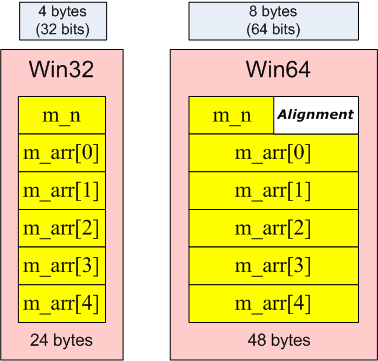Lesson 21. Pattern 13. Data alignment
Processors work more efficiently when the data are aligned properly and some processors cannot work with non-aligned data at all. When you try to work with non-aligned data on IA-64 (Itanium) processors, it will lead to generating an exception, as shown in the following example:
#pragma pack (1) // Also set by key /Zp in MSVC
struct AlignSample {
unsigned size;
void *pointer;
} object;
void foo(void *p) {
object.pointer = p; // Alignment fault
}If you have to work with non-aligned data on Itanium, you should specify this explicitly to the compiler. For example, you may use a special macro UNALIGNED:
#pragma pack (1) // Also set by key /Zp in MSVC
struct AlignSample {
unsigned size;
void *pointer;
} object;
void foo(void *p) {
*(UNALIGNED void *)&object.pointer = p; //Very slow
}In this case the compiler generates a special code to deal with the non-aligned data. It is not very efficient since the access to the data will be several times slower. If your purpose is to make the structure's size smaller, you can get the best result arranging the data in decreasing order of their sizes. We will speak about it in more detail in one of the next lessons.
Exceptions are not generated when you address non-aligned data on the architecture x64 but you still should avoid them - first, because the access to these data is very much slower, and second, because you may want to port the program to the platform IA-64 in the future.
Consider one more code sample that does not consider the data alignment:
struct MyPointersArray {
DWORD m_n;
PVOID m_arr[1];
} object;
...
malloc( sizeof(DWORD) + 5 * sizeof(PVOID) );
...If we want to allocate an amount of memory needed to store an object of MyPointersArray type that contains 5 pointers, we should consider that the beginning of the array m_arr will be aligned on an 8-byte boundary. The arrangement of data in memory in various systems (Win32/Win64) is shown in Figure 1.

Figure 1- Data alignment in memory in Win32 and Win64 systems
The correct calculation of the size looks as follows:
struct MyPointersArray {
DWORD m_n;
PVOID m_arr[1];
} object;
...
malloc( FIELD_OFFSET(struct MyPointersArray, m_arr) +
5 * sizeof(PVOID) );
...In this code we find out the offset of the structure's last member and add this value to its size. You can find out the offset of a structure's or class's member with the help of the macro "offsetof" or FIELD_OFFSET.
Always use these macros to know the offset in the structure without relying on knowing the types' sizes and alignment. Here is an example of code where the address of a structure's member is calculated correctly:
struct TFoo {
DWORD_PTR whatever;
int value;
} object;
int *valuePtr =
(int *)((size_t)(&object) + offsetof(TFoo, value)); // OKLinux-developers may encounter one more trouble related to alignment. You may learn what it is from our blog-post "Change of type alignment and the consequences".
Diagnosis
Since work with non-aligned data does not cause an error on the x64 architecture and only reduces performance, the tool PVS-Studio does not warn you about packed structures. But if the performance of an application is crucial to you, we recommend you to look through all the fragments in the program where "#pragma pack" is used. This is more relevant for the architecture IA-64 but PVS-Studio analyzer is not designed to verify programs for IA-64 yet. If you deal with Itanium-based systems and are planning to purchase PVS-Studio, write to us and we will discuss the issues of adapting our tool to IA-64 specifics.
PVS-Studio tool allows you to find errors related to calculation of objects' sizes and offsets. The analyzer detects dangerous arithmetic expressions containing several operators sizeof() (it signals a potential error). The number of the corresponding diagnostic message is V119.
However, it is correct in many cases to use several sizeof() operators in one expression and the analyzer ignores such constructs. Here is an example of safe expressions with several sizeof operators:
int MyArray[] = { 1, 2, 3 };
size_t MyArraySize =
sizeof(MyArray) / sizeof(MyArray[0]); //OK
assert(sizeof(unsigned) < sizeof(size_t)); //OK
size_t strLen = sizeof(String) - sizeof(TCHAR); //OKAppendix
Figure 2 represents types' sizes and their alignment. To learn about objects' sizes and their alignment on various platforms, see the code sample given in the blog-post "Change of type alignment and the consequences".
Figure 2 - Types' sizes and their alignment.
The course authors: Andrey Karpov (karpov@viva64.com), Evgeniy Ryzhkov (evg@viva64.com).
The rightholder of the course "Lessons on development of 64-bit C/C++ applications" is OOO "Program Verification Systems". The company develops software in the sphere of source program code analysis. The company's site.

